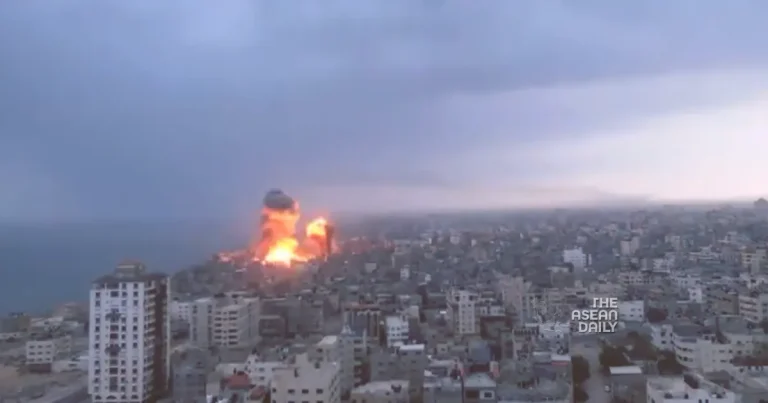9-10-2023 (JERUSALEM) Israel’s military launched a comprehensive operation in the southern part of the country, where it is actively searching for Hamas fighters, securing breaches in its border defenses, and conducting aerial assaults on the Gaza Strip. This operation follows an unprecedented weekend incursion by Hamas, which has left Israel’s military and intelligence community caught off guard.
More than two days have passed since Hamas initiated its surprise attack from Gaza, and the military now reports that the fighting has mostly subsided. This marks the first time in decades that Israel has witnessed intense battles on its streets. On Sunday, Israel officially declared war, foreshadowing further conflict and the possibility of a ground assault into Gaza. Prime Minister Benjamin Netanyahu has expressed his determination to eliminate both the military and governing capabilities of the deeply rooted militant group in Gaza.
As Israel continues to target over a thousand locations in Gaza and deploys tanks and drones to safeguard openings in the border fence, Palestinian militants persist in launching rocket barrages, prompting air raid sirens in Jerusalem and Tel Aviv. Video footage posted online appears to show a plume of smoke near a terminal at Ben Gurion International Airport, although details on casualties or damage remain pending. Civilian casualties have already been substantial, with approximately 700 people killed in Israel, an alarming toll given the recent scale of conflicts. In Gaza, nearly 500 have lost their lives.
Palestinian militant factions have asserted that they are holding more than 130 individuals captured in Israel and transported to Gaza. The armed wing of Hamas reported that four of these captives were killed in Israeli airstrikes, though this claim cannot be independently verified.
Meanwhile, Israeli Defense Minister Yoav Gallant has ordered a “complete siege” on Gaza, which includes cutting off electricity and blocking the entry of food and fuel. Israel and Egypt have imposed various levels of blockades on the territory since Hamas seized power from rival Palestinian forces in 2007. Gallant’s use of dehumanizing language, referring to those in Gaza as “human animals,” reflects the heightened tensions on both sides.
Rear Adm. Daniel Hagari, the chief military spokesperson, announced that Israel has regained “control” of its border communities after around 48 hours of intense battles within the country. He noted some isolated incidents on Monday but stressed that there is no fighting in the communities at this stage. Nevertheless, militants may still be present within Israel, leading to the evacuation of 15 out of 24 border communities, with the remainder expected to follow suit.
Hamas spokesman Abdel-Latif al-Qanoua revealed that the group’s fighters continue to engage outside Gaza and have captured more Israelis as recently as Monday morning. Hamas aims to secure the release of all Palestinian prisoners held by Israel, a goal that has previously led to lopsided exchange deals in which large numbers of prisoners were released in exchange for individual captives or the remains of soldiers.
In its airstrikes, Israel’s military targeted Beit Hanoun, a town in northeast Gaza believed to be used as a staging ground for Hamas attacks. Details on casualties in this area remain pending. The Israeli army has mobilized around 300,000 reservists, constituting a massive deployment.
The overarching objective for Israel is to cripple Hamas’ military and governing capabilities. Hamas has maintained its rule in Gaza for 16 years despite the Israeli and Egyptian blockade and four previous conflicts with Israel.
Following the breach of Israeli barriers by Hamas gunmen on Saturday, who rampaged through various areas, killing civilians and abducting people, Palestinian militants have launched around 4,400 rockets at Israel. The high number of Hamas fighters involved in the initial incursion on Saturday highlights the extensive planning by the militant group, which cited mounting Palestinian suffering as the reason for its attack.
Palestinians seek an independent state in all three territories captured by Israel in the 1967 war. However, serious peace negotiations have stalled for over a decade, with Israel’s current right-wing government opposing Palestinian statehood.
Hamas and the smaller Islamic Jihad group have claimed to have taken soldiers and civilians captive, including women, children, and older adults. The precise number of captives remains undisclosed by the Israeli military but is described as “significant.”
Amid the conflict, fears of further escalation have grown. Israeli airstrikes have demolished 159 housing units and severely damaged 1,210 others across Gaza, according to the United Nations. A school sheltering more than 225 people also took a direct hit, although the source of the fire was not specified.
In southern Gaza’s city of Rafah, an Israeli airstrike killed 19 people, including women and children. Aircraft targeted the home of the Abu Hilal family, causing damage to surrounding residences. Over the weekend, another airstrike in Rafah claimed the lives of 19 members of the Abu Quta family, including women and children.
Israeli media outlets, citing rescue service officials, have reported that at least 73 soldiers have been killed on the Israeli side. In Gaza, the Health Ministry disclosed that 493 people have died, including 78 children and 41 women, while thousands have been injured on both sides. Additionally, Israeli security forces claim to have killed 400 militants and captured dozens more.
The United States dispatched an aircraft carrier strike group to the Eastern Mediterranean on Sunday to assist Israel and pledged to send additional military aid.
In northern Israel, a brief exchange of strikes with Lebanon’s Hezbollah militant group has raised concerns that the conflict may escalate into a wider regional war. The Israeli military stated that the situation has since calmed.
Elsewhere, six Palestinians lost their lives in clashes with Israeli soldiers around the West Bank on Sunday.




